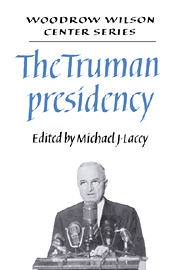Book contents
- Frontmatter
- Contents
- Acknowledgments
- Introduction and summary: The Truman era in retrospect
- 1 The mind and character of Harry S. Truman
- Part I Domestic politics and issues
- Part II Foreign policy and national defense
- 7 The national security state reconsidered: Truman and economic containment, 1945–1950
- 8 The insecurities of victory: the United States and the perception of the Soviet threat after World War II
- 9 Alliance and autonomy: European identity and U.S. foreign policy objectives in the Truman years
- 10 U.S. policy in the Near East: the triumphs and tribulations of the Truman administration
- 11 Toward a post-colonial order: Truman administration policies toward South and Southeast Asia
- 12 Occupied Japan and the cold war in Asia
- 13 The Truman administration and the Korean War
- About the authors
- Index
7 - The national security state reconsidered: Truman and economic containment, 1945–1950
Published online by Cambridge University Press: 06 October 2009
- Frontmatter
- Contents
- Acknowledgments
- Introduction and summary: The Truman era in retrospect
- 1 The mind and character of Harry S. Truman
- Part I Domestic politics and issues
- Part II Foreign policy and national defense
- 7 The national security state reconsidered: Truman and economic containment, 1945–1950
- 8 The insecurities of victory: the United States and the perception of the Soviet threat after World War II
- 9 Alliance and autonomy: European identity and U.S. foreign policy objectives in the Truman years
- 10 U.S. policy in the Near East: the triumphs and tribulations of the Truman administration
- 11 Toward a post-colonial order: Truman administration policies toward South and Southeast Asia
- 12 Occupied Japan and the cold war in Asia
- 13 The Truman administration and the Korean War
- About the authors
- Index
Summary
On 13 May 1948, a dramatic conference took place at the White House. Ever since the communists had seized power in Czechoslovakia in March 1948, a war scare had gripped Washington. President Harry S. Truman had already agreed to add more than $3 billion to the Pentagon's fiscal 1949 budget, raising it to $13 billion, but the Joint Chiefs of Staff (JCS) and the military services were demanding much higher sums for the following years. Now the president had had enough. Supported by Budget Director James E. Webb, Truman flatly told Secretary of Defense James V. Forrestal that he was putting a $14.4 billion ceiling (excluding stockpiling) on the fiscal 1950 defense budget.
As Truman explained to Forrestal, “Military strength is dependent on a strong economic system and a strong industrial and productive capacity.” Before considering higher defense budgets, “the effect on our national economy must be weighed.” Increased military expenditures could bring runaway inflation, taxes, and deficit spending. In fact, unless “world conditions deteriorate and tensions increase,” the president intended to cut the Pentagon budget.
Truman's showdown with Forrestal over the defense budget poses interesting questions about the origins of the cold war. Some of the most decisive battles of the postwar era were fought not along the iron curtain but along the Potomac. The combatants consisted of contending factions within the U.S. government, each with differing ideas about how best to achieve the national security and world peace.
- Type
- Chapter
- Information
- The Truman Presidency , pp. 205 - 234Publisher: Cambridge University PressPrint publication year: 1989
- 2
- Cited by

